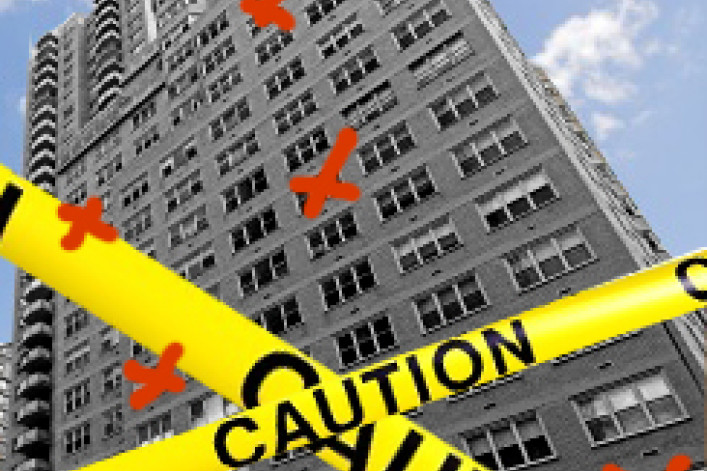The 7 worst places to live in a building | Jan 2011

Few have a better bird’s-eye view of the skeletons lurking inside NYC’s apartment buildings than the property engineers called in to diagnose problems.
To harness that knowledge for the greater good, BrickUnderground asked RAND Engineering & Architecture’s Peter Varsalona for the lowdown on which spots inside a building present the most risk to health, home, pocketbook and/or peace of mind.
Here’s the rundown on where Varsalona says that based on his experience, he would never live, along with BrickUnderground’s two cents:
1. Directly below a roof or a setback terrace
- Varsalona: All roofs leak eventually, and sometimes the culprit is very hard to find. “It can take months or even years,” he says. Moreover, living below a terrace can be noisy. To cut down on the sound of footsteps from above, he says, “you want to at least see pavers--squares of pre-cast concrete 1 ½ or 1 ¾ inches thick—on top of pedestals, and even with that I’ve had clients who can still hear footfalls, and voices too if the windows are open.”
- BrickUnderground: We wouldn’t want to live beneath an active communal terrace, but as for living beneath unused roof area, we think not hearing neighbors overhead may be worth an occasional and hopefully short-lived leak.
2. Next to an elevator shaft:
- Varsalona: A lot of times residents complain of vibrations in the elevator shaftway and sometimes they hear the traveling cables rattling,” says Varsalona. More noise pollution can arrive in the form of loud chatter among residents waiting for the elevator.
- BrickUnderground: If the rattling and vibrations are moderate, and if they are adjacent to a section of your apartment that doesn’t require total silence—say, the kitchen vs. the bedroom—we might be okay with this. Still, we’d want to hear it first, so we wouldn’t buy this apartment preconstruction. We’d also be a tiny bit worried for our audio privacy, as any noise or conversations emanating through our front door would be more likely to be overheard by someone waiting for the elevator rather than a quick passer by.
3. Compactor shaft
- Varsalona: Vibrations are apparently also an issue with some compactors. Moreover, says Varsalona, “I’ve had new buildings where residents complain they hear refuse as it falls down the shaft, so that is another kind of annoyance—especially the resident that drops that one bottle down the compactor shaft in the middle of the night and you listen to it go all the way down."
- BrickUnderground: We concur. It seems to us that the door slamming as residents enter and exit the compactor room could also drive us crazy.
4. Lobby or first floor
- Varsalona: “There are a lot of concerns about living on the level just above the cellar or garage,” says Varsalona. “Besides noise from lobby traffic, you’re always going to have some security concerns. Even in an attended lobby, sometimes a doorman could be distracted by helping someone.” Varsalona says odor problems are also more common in apartments close to the street or above the basement, with garages among the worst culprits: “You certainly don’t want to be above a garage, where cars idle pumping out fumes. What people tend to complain of are gassy smells. It can get really bad. And though it's odorless, carbon monoxide is always a worry.” Apartments above the mechanical room or boiler room, meanwhile, are often treated to the sound of the boilers and pumps going on and off and can pick up vibrations. If you live over a boiler, your apartment is going to be hot—and being on the first floor, you may be loathe to open a window.
- BrickUnderground: There are some excellent bargains to be had on the first floor. Still, we have to agree with Varsalona that we’d be worried about lobby noise and that we’d be very careful about living above anything other than an empty basement area or storage room.
5. Down the hall from a community room or playroom
- Varsalona: “You don’t necessarily want to be next to or along the path of a community room or playroom because of the foot traffic and noise,” says Varsalona. “Usually those spaces are in the cellar, but in newer condos they can be on the second floor or higher.”
- BrickUnderground: If you like the sound of playgrounds and parties, this one’s for you.
6. Along an exterior airshaft
- Varsalona: “Sometimes there is an exterior airshaft or mechanical shaftway that allows the apartment to satisfy the light and air requirements for bedrooms. But you really have to look at the neighboring buildings sharing the shaft, because they’re not all residential. It might be a Chinese food restaurant dumping whatever into the shaftway next to you.”
- BrickUnderground: Remember that in the absence of a nuisance-type neighbor (residential or commercial), airshafts can make lovely, quiet neighbors, providing a respite from noisier street side exposures.
7. Adjacent to an upper-floor mechanical room
- Varsalona: “Mechanical rooms aren’t necessarily all in the cellar—in certain high rises you’ll have them on floors 20, 30, 40 and the roof. They house boilers, a/c equipment, pumps—all kinds of devices that can generate noise, heat and/or vibrations.”
- BrickUnderground: Definitely cause for investigation, and probably a good reason not to buy preconstruction apartments located next to mechanical rooms.
So where’s the best place to live? Varsalona, who owns a prewar co-op apartment in Manhattan, says “somewhere in the middle but at least 2-3 floors below the roof. For myself, I happen to be three floors below the roof.”
Related posts:
The top 7 construction defects, and how not to be a sucker
Your next place: 9 questions that separate the New Yorkers from the rookies
How to buy an apartment that's not for sale using PropertyShark.com (sponsored)
Confessions of a preconstruction buyer
New condos called 'sickest' buildings























